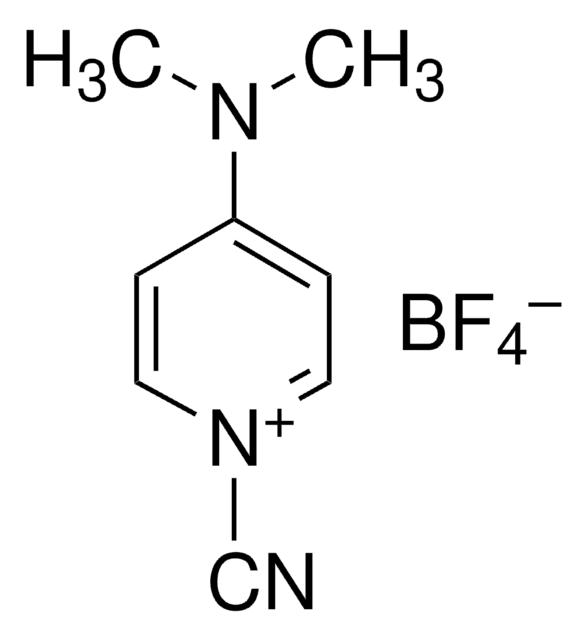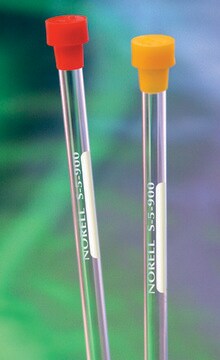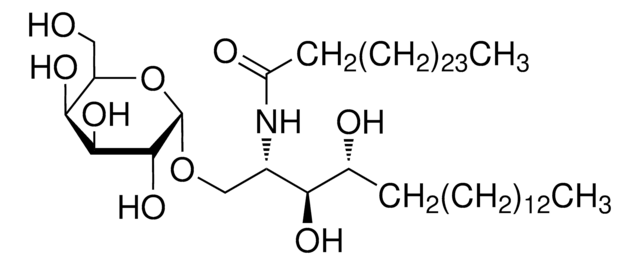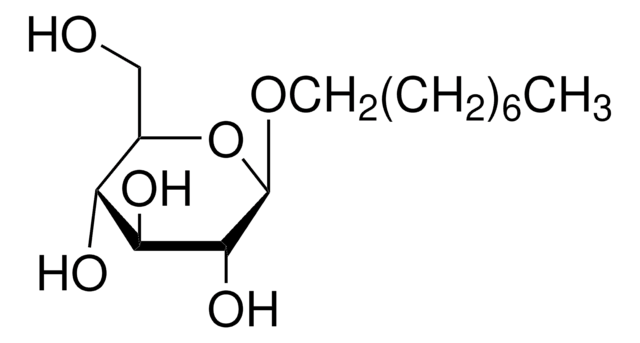Key Documents
SBR00023
1-Cyano-4-dimethylaminopyridinium tetrafluoroborate Ready Made Solution
organic cyanylating reagent, 100 mg/mL in acetonitrile
Synonim(y):
4-(dimethylamino)pyridin-1-ium-1-carbonitrile tetrafluoroborate, CDAP
About This Item
Polecane produkty
pochodzenie biologiczne
synthetic
Próba
≥97%
Postać
liquid
masa cząsteczkowa
234.99
stężenie
100 mg/mL in acetonitrile
Warunki transportu
dry ice
temp. przechowywania
−20°C
InChI
1S/C8H10N3.BF4/c1-10(2)8-3-5-11(7-9)6-4-8;2-1(3,4)5/h3-6H,1-2H3;/q+1;-1
Klucz InChI
MBLVMDCQDCVKNE-UHFFFAOYSA-N
Opis ogólny
Zastosowanie
Działania biochem./fizjol.
CDAP is considered to be a less toxic reagent as compared to cyanogen bromide (CNBr) (a known polysaccharides activator). In addition, CDAP is easier to use as it can be employed at a lower pH and has fewer side reactions. It is known that CDAP polysaccharide activation efficiency is optimal at pH 9-10. It was also reported that direct conjugation of protein to CDAP-activated polysaccharides can be performed under mildly alkaline conditions (pH 7-9). It has also been reported that proteins could also be conjugated to CDAP-activated polysaccharides at pH 5.
Cechy i korzyści
- Readily available solution, that reduces the need for preparation time
- Versatile and adaptable for vaccine and biochemical research
Uwaga dotycząca przygotowania
Inne uwagi
Hasło ostrzegawcze
Danger
Zwroty wskazujące rodzaj zagrożenia
Zwroty wskazujące środki ostrożności
Klasyfikacja zagrożeń
Acute Tox. 4 Dermal - Acute Tox. 4 Inhalation - Acute Tox. 4 Oral - Eye Irrit. 2 - Flam. Liq. 2 - Skin Irrit. 2
Kod klasy składowania
3 - Flammable liquids
Klasa zagrożenia wodnego (WGK)
WGK 3
Temperatura zapłonu (°F)
35.6 °F
Temperatura zapłonu (°C)
2 °C
Certyfikaty analizy (CoA)
Poszukaj Certyfikaty analizy (CoA), wpisując numer partii/serii produktów. Numery serii i partii można znaleźć na etykiecie produktu po słowach „seria” lub „partia”.
Masz już ten produkt?
Dokumenty związane z niedawno zakupionymi produktami zostały zamieszczone w Bibliotece dokumentów.
Nasz zespół naukowców ma doświadczenie we wszystkich obszarach badań, w tym w naukach przyrodniczych, materiałoznawstwie, syntezie chemicznej, chromatografii, analityce i wielu innych dziedzinach.
Skontaktuj się z zespołem ds. pomocy technicznej









